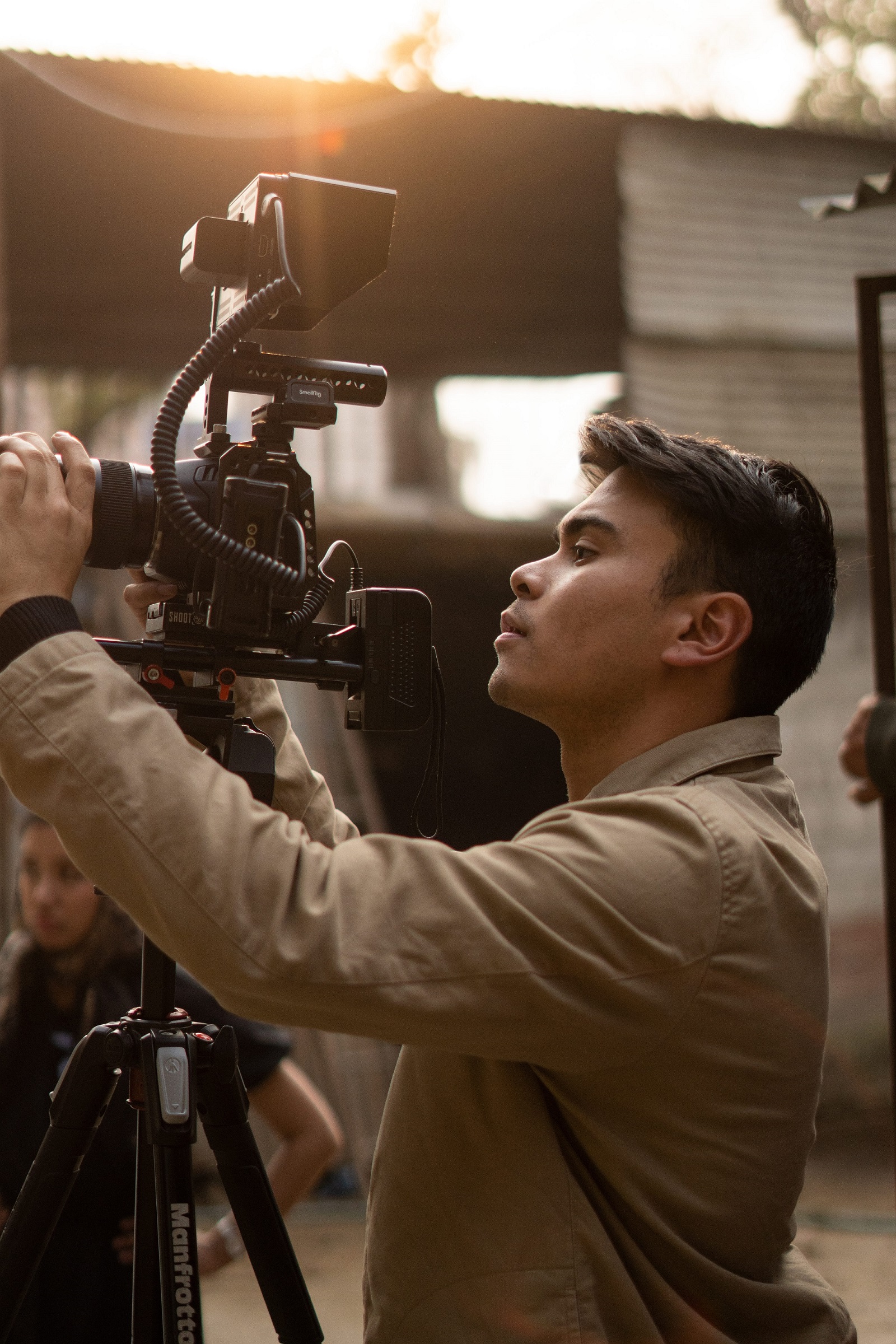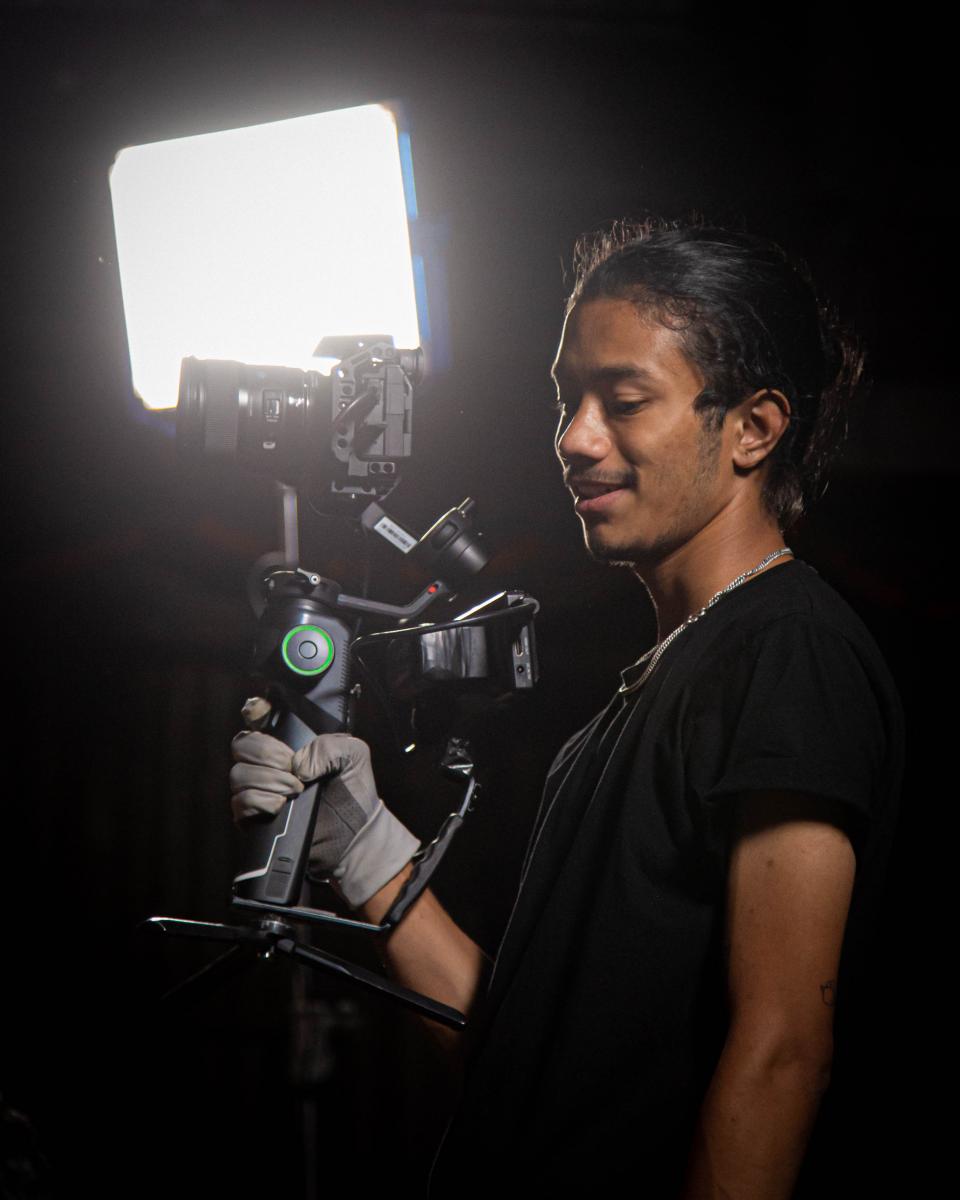Through the Lens: The Rising Cinematographers of Today
Meet the upcoming cinematographers who are breaking new ground in the Nepali cinema industry. With their unique visions and dedication to their craft are pushing the boundaries of cinematography and bringing fresh perspectives to the screen.

Abhushan Chitrakar
Introducing Abhushan Chitrakar: A Dynamic Filmmaker and Photographer Making Waves in the Industry. With 4 years of experience under his belt, Abhushan has worked on diverse projects, from music videos to documentaries. His experimental approach and collaborative spirit have led to the creation of captivating visual stories that push creative boundaries.
1. How do you see the field of cinematography evolving in the future?
The storytelling aspect of cinematography is evolving and becoming more diverse. Cinematographers are exploring different methods and visual styles, resulting in unique and culturally representative films. I believe that this trend will continue, and we will witness more films with distinctive stories and perspectives. As individuals, we draw inspiration from various sources and are becoming better at conveying these stories in our own unique ways. This has opened up opportunities to showcase diverse voices and cultures, making the film industry a more inclusive and exciting space.
2. What is your approach to cinematography and how do you work with clients to achieve their vision?
As a cinematographer, it's crucial to remain open to new ideas and approaches. While I acquired much of my knowledge as a solo filmmaker, I believe in the benefits of collaborative work. I encourage my clients to explore experimental methods and stray away from conventional storylines. In my work, I prioritize pre-production to ensure everything runs smoothly during filming. Assigning designated responsibilities to each member of the team can enhance accountability and strengthen the project's overall outcome. By remaining open to new ideas and maintaining a strong team dynamic, we can create impactful and innovative films.
3. What advice do you have for aspiring cinematographers?
In cinematography, it's essential to surround yourself with individuals who can inspire and challenge you to push your limits. Collaboration is a significant aspect of this art form, and a supportive team can help bring your vision to life. To grow as a cinematographer, I recommend watching a diverse range of films to gain inspiration and jot down your own ideas. Exploring various genres and styles can also help you identify your strengths and preferences in creating films. By experimenting and continuously learning, you can develop your skills and create impactful and innovative films.
4. What has been the most rewarding aspect of your work so far?
Expressing myself creatively through cinematography/filmmaking has been an incredibly rewarding experience. As a shy kid, I struggled to express myself verbally, but through the lens of a camera, I can convey my thoughts and emotions in a way that feels authentic to me. I find inspiration in the power of visual storytelling and it is a privilege to share my work with others. Cinematography has not only honed my technical skills but has also allowed me to grow personally and emotionally.

Abin Shakya
Abin Shakya, is an aspiring cinematographer currently studying at Oscar International College. With a keen eye for detail and a passion for storytelling, Abin has already made strides in the industry, capturing TV shows and honing his craft. Abin's journey as a cinematographer explores his experiences and insights in this dynamic and ever-evolving field.
- What role do you see technology playing in the future of cinematography, and how do you stay up-to-date with the latest tools and techniques?
Technology has revolutionized cinematography by introducing new tools and techniques. Arial view drone shots have changed the perspective of cinematography, adding a new dimension to establishing shots. The latest drone technology like the FPV (First Person View) drone has its own advantages and disadvantages. Furthermore, advanced camera angles and VFX techniques, such as green screens, have made technical factors more precise. To stay up-to-date with these advancements, cinematographers must attend workshops, seminars, and exhibitions and follow social media and industry blogs to learn about the latest tools and techniques. The future of cinematography is undoubtedly bright, and advancements in technology will continue to play a significant role in enhancing visual storytelling.
- What is the cinematography from your point of view?
Cinematography is the art of visual storytelling through the use of a camera and lighting techniques. It's a continuous learning process and requires passion and creativity to make an impact. With the evolution of technology and the emergence of talented cinematographers like Abin Bho, Darshan Pokhrel, Jholey, and Sisan Baniya, the field is constantly evolving. However, it's not just about making money but rather expressing your vision and showing people your perspective through your work.
- Is there anything else you would like to share about your work or experiences that you think would be relevant or interesting for readers interested in learning about cinematography?
My experiences in the music industry as a cinematographer have taught me the importance of teamwork and collaboration. Working on projects like "Aftero Awastha" by Bekhcha, the Newari music video “swonti wola” and working with the team musicophiles studio have been some of my best experiences as a cinematographer. The bond that we create while working together with a shared vision is what drives and motivates us. I've also learned a lot from online platforms such as Instagram and YouTube, where I learned photography in-depth. For those interested in cinematography, I suggest exploring these online resources and also considering studying in-depth at colleges specializing in this field.
- What are the common challenges and obstacles that cinematographers face in their work?
Cinematographers often face various challenges and obstacles in their work, including issues with timing, lack of punctuality from crew members and actors, and unpredictable natural lighting conditions. Additionally, working with limited budgets can limit access to high-end equipment and resources, making it difficult to achieve the desired cinematic look. Furthermore, cinematographers must also navigate creative differences with directors and producers and ensure that their vision aligns with the project's overall goals. Finally, the physical demands of the job, such as carrying heavy equipment and working long hours, can also take a toll on cinematographers.

Nischal Manandhar
Meet Nischal Manandhar, a rising cinematographer hailing from Kirtipur, Nepal. With a bachelor's degree in media studies from Kathmandu University School of Arts, Nischal has already begun to make a name for himself in the industry. Currently working at Kathaharu Production, he brings his unique perspective and creative vision to the world of visual storytelling. Let's take a closer look at his journey and experiences as a cinematographer.
- How did you get interested in cinematography, what inspired you to pursue a career in this field?
During a classroom discussion about future aspirations, I declared my desire to become an artist, only to be ridiculed by my classmates due to my lack of painting skills. My teacher, however, broadened the definition of an artist to include various creative fields, inspiring me to take up photography. Pursuing a degree in media studies, I later delved into videography and established a career as a cinematographer. That experience taught me to define success on my own terms and not be limited by others' narrow perspectives.
- What are some of the most important lessons you've learned about storytelling through cinematography, and how do you apply those lessons to your work?
As a cinematographer, I've learned that the way a scene is shot has a significant impact on the story's tone, pace, and emotional resonance. To effectively convey the director's vision, we must carefully consider composition, camera angles, movements, and lighting to bring out the intended emotional response from the audience, whether it be tension in a dramatic scene or happiness in a joyous moment.
- What trends or changes have you noticed in the field recently?
As a cinematographer in the cinematography industry, I have witnessed significant changes in the past five years. From the availability of high-end equipment to evolving styles and trends, the industry is in a constant state of flux. Social media platforms like TikTok and Instagram have played a significant role in shaping these changes, with clients now prioritizing viral content over video quality. This shift has presented new challenges, such as conveying our message in just one or two minutes and adapting to changing market demands. However, these changes have also inspired us to innovate and learn to deliver compelling visual stories that capture our audience's attention.
- What role do you think film and visual storytelling play in connecting people across cultures and generations, and how do you hope your work contributes to that?
The art of storytelling has the potential to forge an emotional connection between the storyteller and their audience, thus bridging the gaps between individuals of diverse backgrounds. When a story resonates with someone, it creates a sense of shared experience that surpasses cultural, generational, and other differences. In my current pursuit of documentary cinematography, I relish capturing the raw visuals that bring stories to life. As a member of the Newari culture, I have a deep desire to showcase and document its rich cultural heritage. My goal is to promote the Newa culture to the world and preserve its traditions for future generations through the power of visual storytelling.


